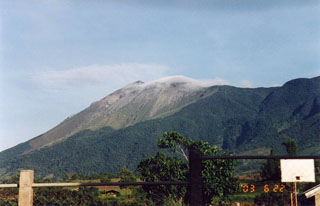Report on Kanlaon (Philippines) — 15 June-21 June 2016
Smithsonian Institution / US Geological Survey
Weekly Volcanic Activity Report, 15 June-21 June 2016
Managing Editor: Sally Sennert.
Please cite this report as:
Global Volcanism Program, 2016. Report on Kanlaon (Philippines) (Sennert, S, ed.). Weekly Volcanic Activity Report, 15 June-21 June 2016. Smithsonian Institution and US Geological Survey.
Kanlaon
Philippines
10.412°N, 123.132°E; summit elev. 2435 m
All times are local (unless otherwise noted)
Based on visual observations, PHIVOLCS reported that a series of three eruptive events occurred at Kanlaon on 18 June, beginning at 0919 and lasting 27 minutes. These events were recorded by the seismic monitoring network as consecutive explosion-type earthquakes that lasted 30, 42, and 29 seconds, respectively. The first event, a steam-and-gas explosion, generated a light gray-to-white ash plume that rose 1.5 km above the crater and then later to 3 km. The second event, an ash eruption immediately following the first event, produced a dense black ash plume that rose 500 m. Lastly, a grayish ash plume rose 500 m. Minor ashfall was reported to the W in the barangays of Ara-al, San Miguel, and Yubo in La Carlota City (14 km W), Sag-ang in La Castellana (16 km SW), and Ilijan in Bago City (30 km NW). A diffuse sulfur odor was detected in Ara-al. The Alert Level remained at 1 (on a scale of 0-5).
Geological Summary. Kanlaon volcano (also spelled Canlaon) forms the highest point on the island of Negros, Philippines. The massive andesitic stratovolcano is covered with fissure-controlled pyroclastic cones and craters, many of which are filled by lakes. The largest debris avalanche known in the Philippines traveled 33 km SW from Kanlaon. The summit contains a 2-km-wide, elongated northern caldera with a crater lake and a smaller but higher active vent, Lugud crater, to the south. Eruptions recorded since 1866 have typically consisted of phreatic explosions of small-to-moderate size that produce minor local ashfall.
Source: Philippine Institute of Volcanology and Seismology (PHIVOLCS)

